You might be someone who struggles to identify different types of wasps around your home and garden. There are over 4000 kinds of wasps living in the United States and ten thousand others in the world.
As simple as identifying their images may sound, you might want to know a thing or two about the wasp family. Some wasps are more dangerous than others since they can cause painful stings.
These flying creatures have close similarities with hornets and bees. Both are important pollinators and can cause unprovoked stings. Let us look into the topic above and more in this article.
Wasps Overview
Wasps are flying winged insects that belong to the Hymenoptera order1. These flying insects are related to bees, hornets, and ants.
Wasps have varying body size that ranges from 0.1mm to 5 cm. The chalcid wasp measures about 0.139mm, while the female cicada killer measures 5 cm long.
These flying creatures can be solitary or social wasps, where the former are the vast majority and most predators. Social wasps live in colonies with a dozen individuals.
The social wasps belong to the Vespidae family comprising hornets and yellow jacket wasps, the most aggressive kinds of wasps.
The solitary wasps are grouped into cuckoo, tiphiid, scoliid, and velvet. These wasps are more parasitic and do not build colonies2. Below is a quick table for types of wasps’ identification:
| Types of Wasps | Scientific Name | Identification Features |
| Paper Wasps | Polistinae | Have slender brown or black body with yellow markings, thin waists, and long dangling legs. |
| Northern Paper Wasps | Polistes fuscatus | Have a slender dark brown body with yellow bands and red dots on its abdomen. |
| European Paper Wasps | Polistes dominula | Have black and yellow bodies with orange antennae and wings. |
| Black and Yellow Wasps | Polistes Comanches | Have black thorax, orange antennae, and yellow and orange abdomen with thin brown bands. |
| Yellow Paper Wasps | Polistes flavus | Have a yellow body with orange and brown markings. |
| Guinea Paper Wasps | Polistes exclamans | Have banded slender yellow and orange-brown abdomen with yellow tips antennae. |
| Red Paper Wasps | Polistes Carolina | Have a reddish-brown body with black wings. |
| Yellow Jackets Wasps | Vespula spp | Have a black and yellow striped body with black antennae and orange or yellow legs. |
| Bald-Faced Hornet | Dolichovespula maculata | Have a black and smooth body with white facial patches and three white stripes on its tail end. |
| Giant Ichneumon Wasp | Megarhyssa macrurus | Female species have long tails and male counterparts lack tails. |
| Mason Wasps | Eumenidae | Have a black and brown smooth body with colorful bands around the abdomen. |
| Black and Yellow Mud Dauber Wasps | Sceliphron caementarium | Have a black body with yellow legs and a thin petiole joining the thorax and abdomen. |
| Blue-Winged Scoliid Wasps | Scolia dubia | Have dark blue wings with a black head and thorax. The Black and red abdomen has yellow dots |
| Eastern Velvet Ant | Dasymutilla occidentalis | Have fuzzy red thorax and abdomen with black bands |
| Spider Wasps | Pompilidae | Have dark slender bodies with transparent-blackish wings and long spiny legs. |
| Cicada Killer Wasps | Sphecius | Have a plump body with a black or reddish-brown abdomen and yellow bands. The dark thorax has reddish markings. |
| Thread-Waisted Wasps | Ammophila procera | Have a narrow waist with a plump orange-banded abdomen and long skinny legs. |
| German Yellow Jacket Wasps | Vespula spp | Have black spade-shaped marks on the abdomen with yellow stripes |
| Southern Yellow Jacket | Vespula spp | Have distinctive black and yellow patterns |
| Braconid Wasps | Braconidae | Have red bodies and blackheads |
| Potter Waps | Eumeninae | Have Black bodies with a yellow band above the thorax and another one on the abdomen. |
| Great Black Wasps | Sphex pensylvanicus | Have shiny black bodies with a bluish shade. |
| Cuckoo Wasps | Chrysididae | Have a Distinctive metallic green body with black wings and legs |
How to Identify Wasps
Wasps can be identified by looking at their color, size, shape, and habits3. Most wasps have smooth and slender bodies with a thin waist between the thorax and abdomen.
Most wasp species have yellow and black colors, but other species might be brown, black, and red. The six spindly legs are other distinctive features of wasps.
Wasp’s legs can be black, yellow, or orange, though it depends on the species. The bi-colored legs are among the leading features to identify different types of wasps.
Different Types of Wasps with Pictures and Names
Paper Wasps
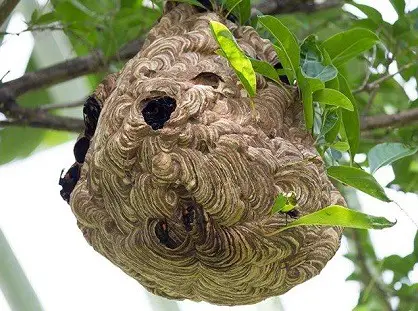
Paper wasps belong to the vespid wasps’ group with slender dark-brown or black bodies and yellow bands. The thin waist, orange-tipped antennae, and long brownish wings are distinctive features.
These wasps hail from North America with over 300 species. They are also known as umbrella wasps due to their papery nests. These wasps chew on plant fiber or wood to create a papery substance for nesting.
Paper wasps’ love sheltered areas like attics and tree branches. They can also cause painful stings when their nest is under threat. The nasty sting becomes red and swollen causing severe allergic reactions in some people.
Northern Paper Wasps
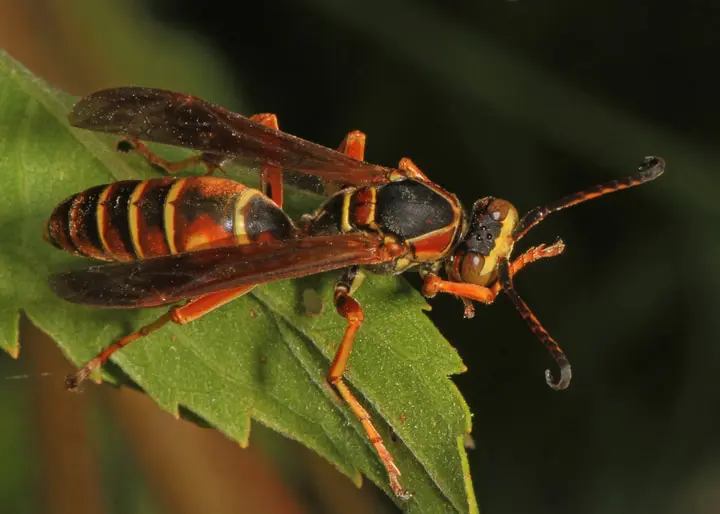
These wasps have dark-brown or black bodies with yellow bands. The thin waist, slender abdomens, and brownish wings are also crucial distinctive features. The abdomen also has some bright red spots.
Northern paper wasps are native to the eastern part of North America. Northern paper wasps with black bodies without markings are common in Florida and British Columbia in the North.
European Paper Wasps
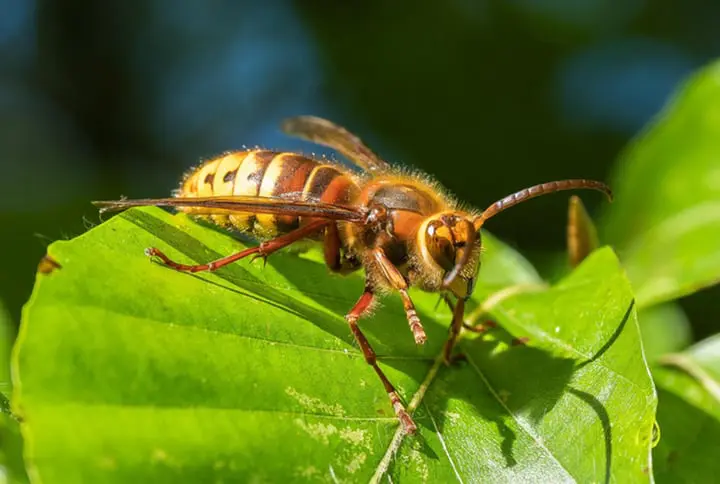
European paper wasps belong to the social wasp group since they love living in colonies of a dozen individuals. These wasps hail from the United States and are more aggressive paper wasps.
These wasps have a yellow-spotted thorax with a black and yellow abdomen. The orange antennae and orangey-yellow legs make these species stand out from others. They also build papery nests in the spring for the queen to lay eggs and for brooding.
Black and Yellow Paper Wasps
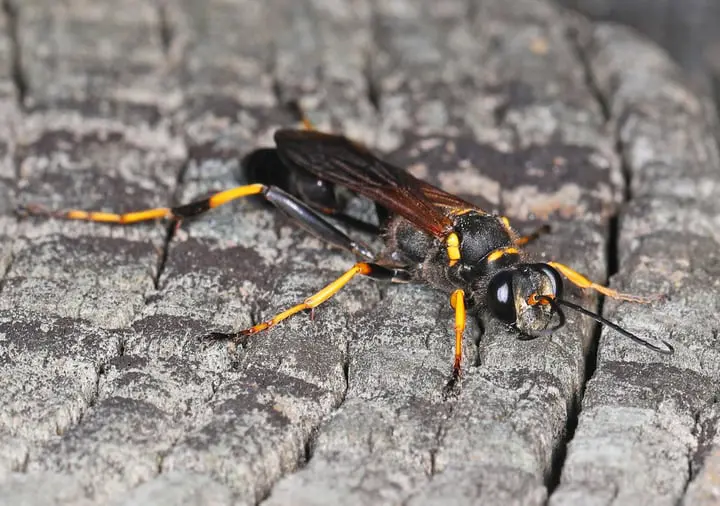
These wasps have a black thorax and bright yellow colored abdomen. They also have a thin waist between the abdomen and thorax.
These wasps also have yellow and orange abdomen with thin brown bands. The dark wings and orange antennae make them distinctive. They hail from the Southern part of the USA.
Yellow Paper Wasps
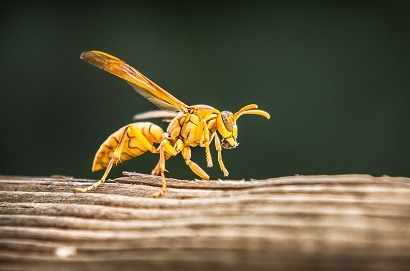
These are brightly colored vespid wasps with a yellow abdomen, orangey-yellow thorax, brown wings, and yellow legs.
These wasps can reach 3cm long at maturity, and they hail from Arizona, New Mexico, and Texas.
Guinea Paper Wasps
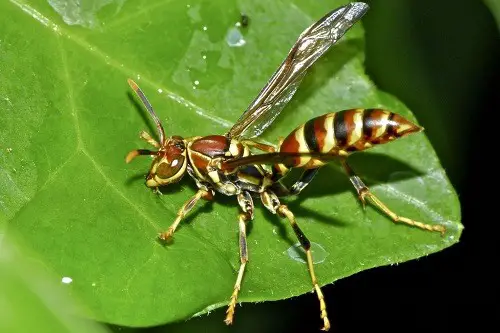
These wasps have orangey-brown to the yellow body with a striped abdomen and black marking on their thorax. They also have a slender body, thin abdomen, and flattened triangular face.
Guinea paper wasps’ body colors depend on their habitat. These wasps species have banded antennae with orange, yellow, and black colors.
Red Paper Wasps
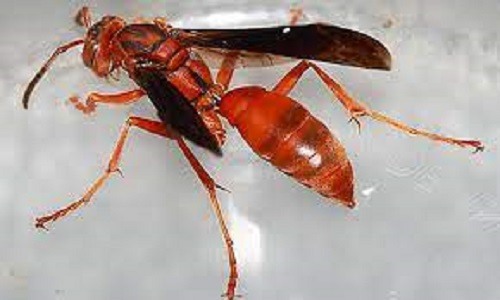
These red-colored wasps have black wings and red antennae. Besides that, they are less aggressive although they sting.
These wasps build oval papery nests under roof overhangs or eaves. They love living near human habitation.
Yellow Jacket Wasps

These wasp species have black bodies with orangey-yellow bands. The smooth bodies and thin abdomen help differentiate them from hornets and honeybees.
Yellowjacket wasps nest in hollow trees, ground, cracks, and crevices. They are relatively small and can reach 1.2cm.
Bald-Faced Hornet
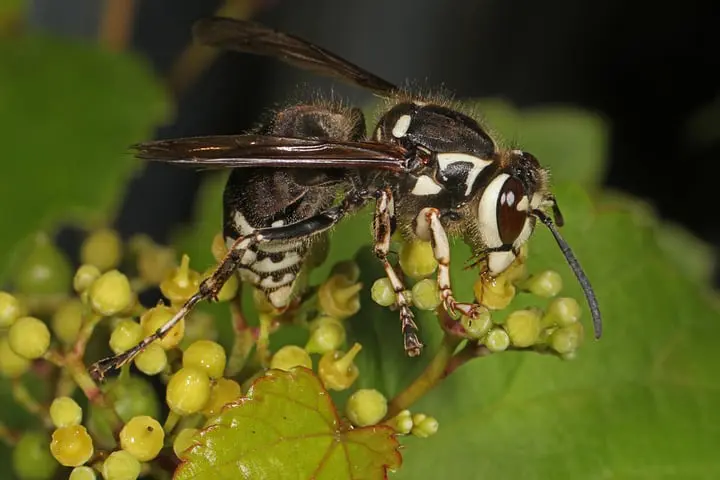
These wasps have black antennae and flattened black faces with a white stripe. The black and white leg coloration makes them be a type of yellow jacket wasps.
Bald-faced hornets are also called white-faced hornets, white-tailed hornets, bald-faced wasps, and bald-faced aerial yellow jackets.
These wasps have hanging papery nests with 400 and 700 individuals. They love living in wall cavities, under roof hangs, and on tree branches.
Giant Ichneumon Wasp
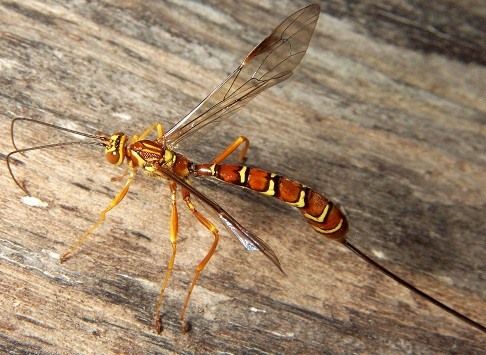
It is a brown wasp species with a long tail and a slender body. The abdomen has yellow and black markings to give it a striking appearance.
These wasps sting do not contain venom and the tail can reach 5cm long. The female species lay eggs under tree bark and can grow up to 13cm long.
Mason Wasps
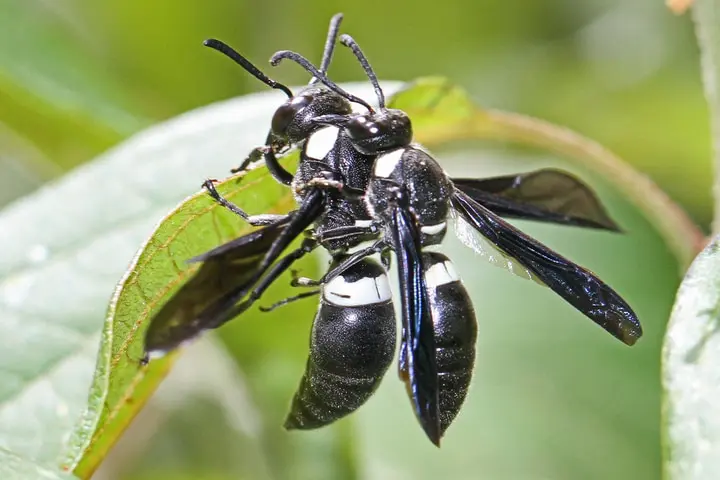
These are black wasps with yellow bands around their abdomen. These wasps are also known as potter wasps. They come in different colors such as orange, yellow, and red.
Some black masons have green to metallic shimmering colors. These small and slender striped insects build mud nests that look like clay bottle vases.
Black and Yellow Mud Dauber Wasp
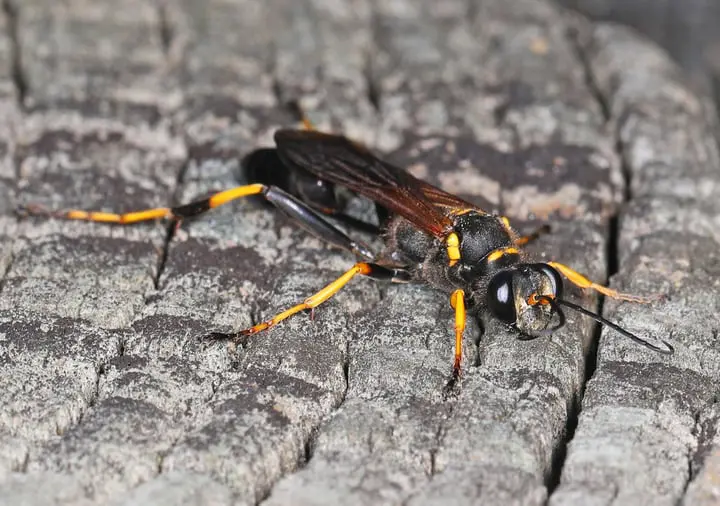
These are black wasps with yellow legs and a prominent long thin waist joining the thorax and abdomen. They also have long wings with dark tawny colors.
These wasps with black thorax and yellow markings prefer building their nests from mud. They can grow up to 2.4-2.8 cm long.
Blue-Winged Scoliid Wasp
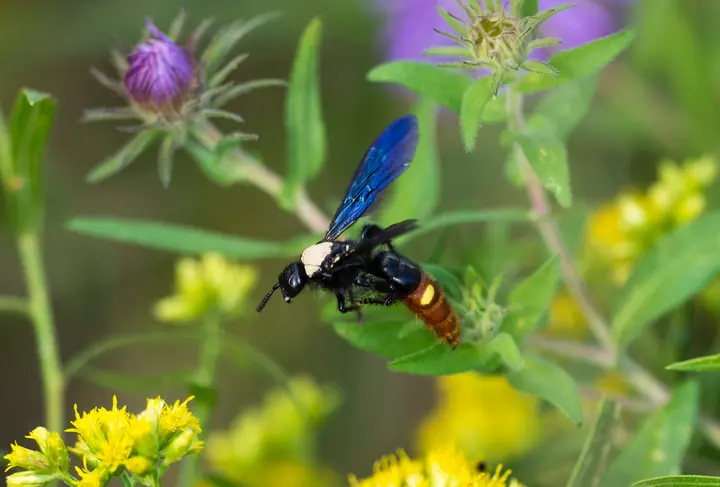
These are large black and red wasps with two prominent bright yellow spots on their abdomen. The iridescent blue wings make these wasps appear black.
These wasps help in controlling the beetle population in the gardens. Female wasps burrow in the ground to lay eggs that hatch into June beetles and Japanese beetles.
Eastern Velvet Ants

It is a furry red and black wasp that looks like an ant. The female wasps are wingless with a red abdomen and a conspicuous black band around the middle.
Male eastern velvet ants can fly since they have black wings. They are also called cow killers since they can give nasty stings. These wasps can grow up to 1.9cm.
Spider Wasp
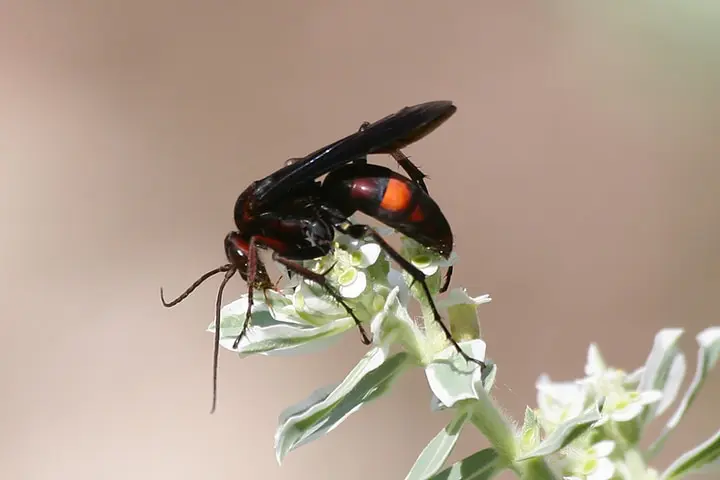
These wasps belong to the pompilid family due to their black or dark blue bodies. They have large heads and fuzzy black abdomens.
Some spider wasps have yellow, white, red, or orange markings. They also have long spiny legs with fine hairs covering the abdomen and hind legs.
Cicada Killer Wasp

These are ground-dwelling wasps in North America with black or brown bodies and yellow bands around the abdomen.
The black antennae and transparent brown wings help distinguish them from yellow jacket wasps and hornets. These wasps can grow up to 5cm long.
Thread-Waisted Wasps
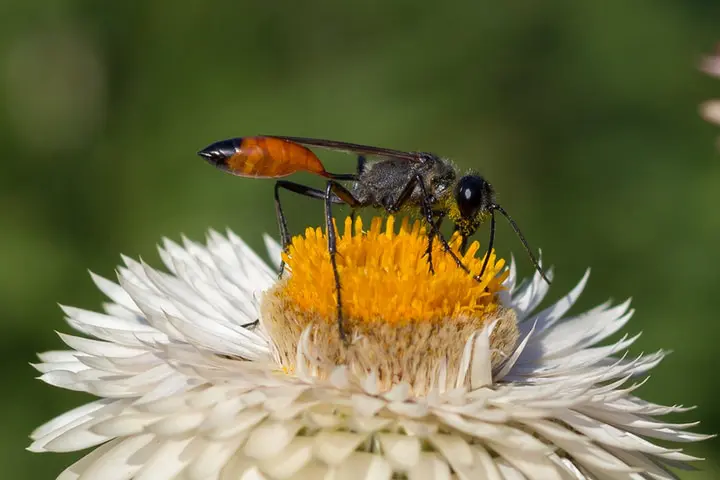
These black wasps have a long waist joining the thorax and abdomen. Other distinguishable features are a black bulbous head, black antennae, and black abdomen with an orangey-red band across it. They have venomous stingers.
German Yellow Jacket Wasps
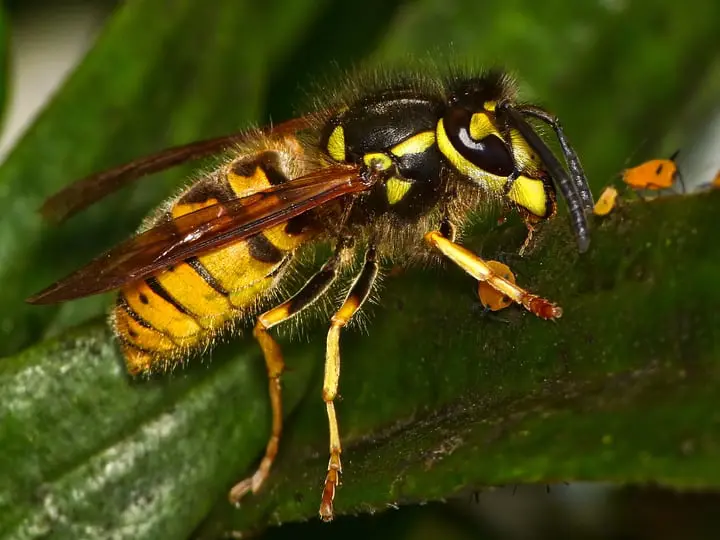
These wasps have black and yellow stripes pattern that resemble common yellow jacket wasps. The spade-shaped black marks on their abdomen make them distinguishable.
Southern Yellow Jacket Wasps
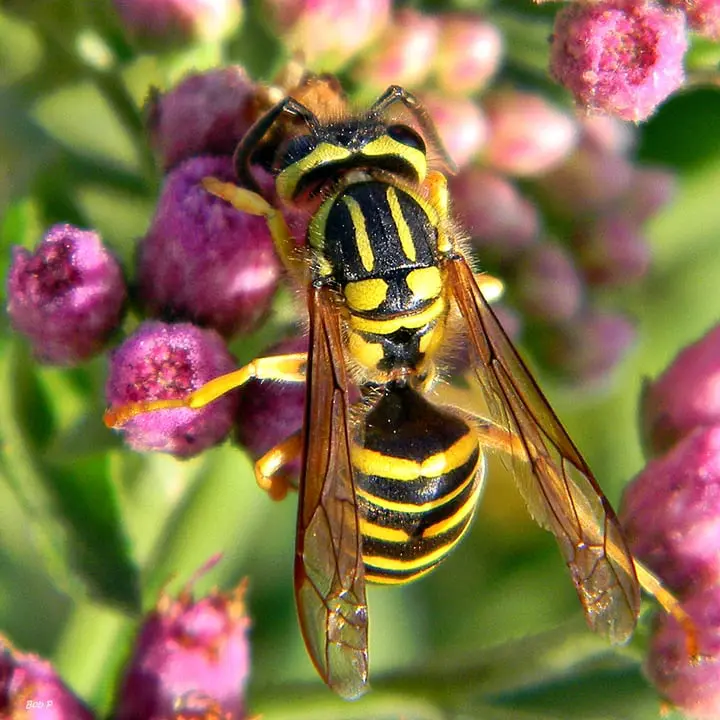
These black and yellow striped wasps are aggressive towards humans and other yellow jacket species. They invade the nests of weaker wasps in the jungle.
Braconid Wasps

These wasps have red bodies with blackhead, antennae, legs, and wings. They use a long needle that looks like a stinger to deposit eggs in the tree holes to protect them from predators.
Potter Wasps
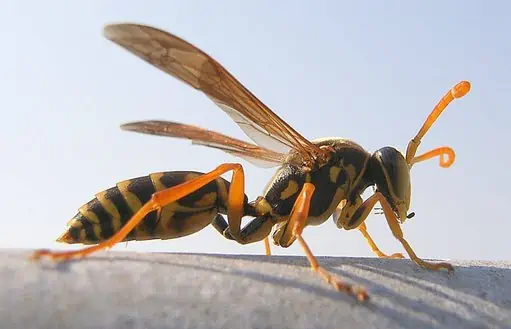
These solitary wasps love to kill caterpillars and feed on them. They have black bodies with yellow bands over their thorax. Some species have yellow spots on their abdomen.
These wasps love to lay eggs in abandoned nests since they do not build nests. They help control caterpillar populations in the garden.
Great Black Wasps
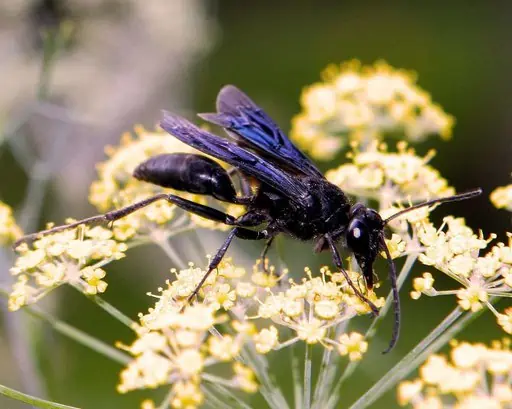
These large wasps have bluish and shiny black bodies. They live in the caves and do not attack human beings. They help control pests populations on crops and facilitate pollination.
Cuckoo Wasps
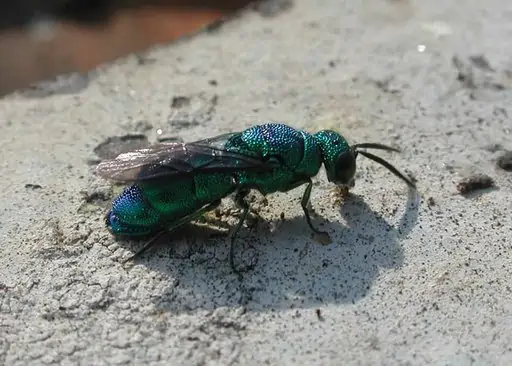
The wasp has a mix of bright green and red on its exoskeleton. They are also known as red-tailed wasps due to their body coloration.
These wasps curl up in a ball shape if they feel threatened. They lay eggs in the nest of solitary wasps since they do not build nests.
Related Questions
What Is the Difference Between Wasps and Hornets?
Hornets measure about 3.8cm long while wasps measure 1cm long or smaller. Besides that, hornets have black bodies and white rings while wasps have yellow and black bodies. But both are aggressive towards humans.
What Is the Difference between Wasps and Bees?
Bees have fuzzy and more barrel-shaped bodies than the slender body shape of wasps with a thin waist.
You May Also Like:
